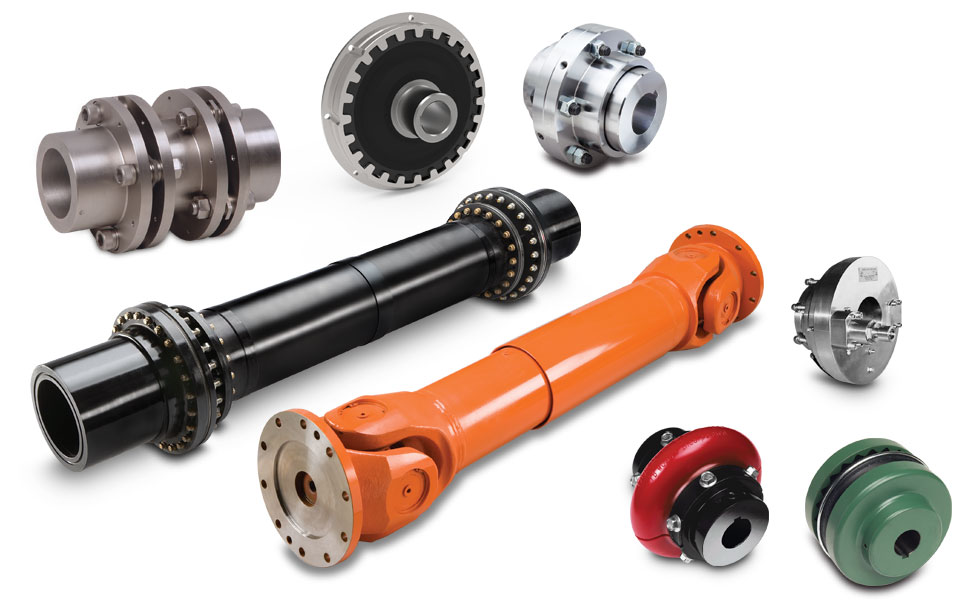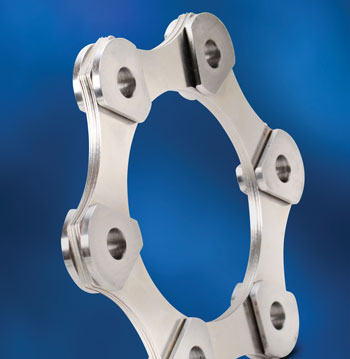
by Jack McGuinn
Senior Editor, Power Transmission Engineering
Excerpted From- Couplings: Designed to Carry the Pay(load)
Couplings. There certainly is no shortage of couplings — or things to
couple them with. There also seems to be no lack of applications for
them. You say you need to reduce the transmission of shock loads from
one shaft to another? That’s a classic application for shaft couplings;
but really, couplings are application-intensive. They’re everywhere.
A coupling is defined as a device that links two shafts together at
their ends for transmitting power. If designed and installed correctly,
couplings do not typically allow disconnection of these shafts during
operation. However, there are — and this is just one example —
torque-limiting couplings that sometimes slip or disconnect when
things get too, well — torquey — and a specified limit is exceeded.
Indeed, the primary purpose of couplings is to join two pieces of
rotating equipment while permitting some degree of misalignment or
end movement — or both. (Think of coupled rail cars and how they
bob and weave their way down straight and curved track.) By careful
design, best-for-application selection, and expert installation and
robust maintenance of couplings, significant savings can be realized in
reduced maintenance costs and downtime.
In an attempt to obtain a better grasp of today’s coupling
technology and some industry insight, we were very lucky to catch up
with a couple of gracious-but-busy guys that made some time to answer
a few questions for us. That would include John Malik, Altra Industrial
Motion, couplings business development manager.
Just to get it out of the way, we asked the current elephant-in-theroom
question. How are the tariffs — real and threatened — and other
ongoing trade machinations affecting your business and or industry?
John Malik (JM). Tariffs are driving cost increases for raw
materials used by domestic manufacturers. In some cases, this puts
domestic production at a further disadvantage vs. imported finished
components which are not subject to tariffs. In addition, the tariff
implementation requires significant resources to determine and pass
along the resulting price increases. On the other hand, due to the
tariffs, we’ve seen increased business as domestic metal mills ramp up
their production.
What if any supply chain issues have arisen due to the tariffs and
trade war back-and-forth? (With supply chain meaning either materials
availability or available strategic manufacturing partners like, for
example, machine shops and/or power transmission components?
JM. The first issue has been reduced supply availability because
companies are buying and hoarding material in advance of tariffs. We
are also seeing escalating raw steel costs. Re-shoring of production,
by Jack McGuinn
Senior Editor, Power Transmission Engineering
where it makes sense, is consuming available machining resources
internally and at subcontractors.
There appears to be increasing demand from certain sectors of the
marketplace for both higher speeds and torque — pushing the
application envelope, in fact. How is your company dealing with that?

Altra coupling brands have developed the
Tri-Bushing™, a unique flex element/blade
triangular bushing design that increases the
axial capability of high performance flexible
disc couplings used in turbomachinery
applications.
JM. Our recent coupling product development initiatives have
been focused on increasing capacities to meet these demands. We’ve
recently increased the torque capacity of our Sure-Flex Plus elastomer
couplings by 30%. We also frequently alter our gear and disc coupling
products to accommodate higher torques and speeds. Applications
requiring these performance increases seem to happen more frequently
as time goes on. In our high-performance disc coupling range, our
new patent-pending Tri-Bushing technology allows for a 33% increase
in axial misalignment capacity. This improved capability is critical in
higher speed and torque applications using steam or gas turbines.
It has been reported that certain coupling speeds typically needed
only for lower torque applications are now being specified for larger
transmission components. How does that affect your business?
JM. We have seen steadily increasing demand for couplings in
the larger end of our product ranges. This has required us to develop
larger sizes in some product lines. It’s also driven significant investment
in manufacturing capacity and technology as outsourcing options
are more limited in larger size ranges. Higher operating speeds are
driving demand of higher precision products with tighter fits, dynamic
balancing and other modifications.
The popularity of full-service, onestop (vertical) suppliers
continues to grow. Do you find that to be accurate, and if so how is your
company dealing with that?
JM. Altra Industrial Motion has continued to grow our portfolio
of coupling product solutions. In recent years, we’ve added Guardian
Couplings and Stromag to our family of worldclass coupling brands
that also includes TB Wood’s, Ameridrives, Bibby Turboflex and
Lamiflex.
Many of the larger scope projects we get involved with require a
variety of coupling types to meet a wide range of specific application
requirements. Our goal is to provide customers with optimized product
performance combined with timesaving, single-source convenience.
This capability is especially important when dealing with customers
that have operations around the world.
Another advantage of Altra’s multibrand approach is that the
engineering teams from various coupling brands routinely collaborate
to analyze specific customer applications and then apply the latest
technologies in design, materials and manufacturing. This added
engineering depth provides value to our customers as it yields optimum
coupling solutions more quickly, whether a modified standard product
or a custom solution is required.
We have been successful as a one-stop supplier in key industries
including Petro- Chem, Metals, Power-Gen and Oil & Gas with
products in virtually every category of flexible couplings. We are also
more focused on repair and renewal services.
In heavy-duty industrial applications, there are reports of a
growing reliance on modular ball-detent torque limiters, rather than
the more traditional means of protecting against overload damage in
high-powered drive systems. As more production capacity is being
used, the downtime to replace shear pins and reset less advanced
overload devices becomes more of an issue. As self-contained,
mechanically resettable torque limiters reduce downtime after overload
disengagement, their value is increasing. Could you please respond to
this assessment?
JM. We agree with this assessment. We have seen large increases
in sales of our Bibby Modular Torque Units. These units have been
designed specifically to offer an alternative to shear pins where their
accurate release torque repeatability reduces downtime. These torque
limiters can be factory preset or set in the field and can be combined
with many of our flexible coupling products.